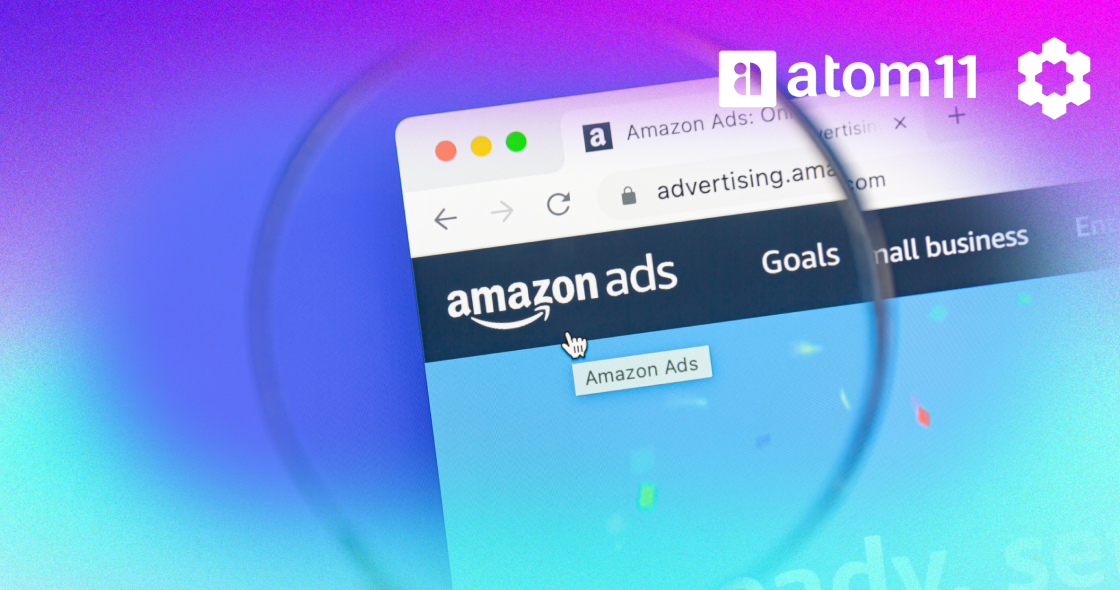Amazon vendors, or first-party (1P) vendors, use an independent Amazon Advertising console to run ads, increase their visibility on the platform, and drive higher sales. However, while third-party (3P) sellers face their own challenges, vendors encounter unique obstacles in advertising, including insufficient data, limited control over inventory and pricing, and restrictions on buy-box-driven advertising.
The truth is that very few Amazon PPC and analytics software cater to vendors’ needs.
This blog provides a guide to help 1P sellers navigate these limitations and get the most out of their Amazon vendor ads.
The Power of Amazon Vendors Ads
Without proper visibility, even the best products can remain hidden in the vast marketplace. In fact, in 2023, Amazon’s ad revenue surpassed $40 billion, making it one of the most significant advertising platforms in the world.
With billions spent on Amazon ads every year, not using Amazon Vendor Central advertising tools is akin to losing out on a massive opportunity. Vendor ads don’t just increase visibility—they’re a driving force behind sales growth. If you’re not investing in Amazon advertising, you’re leaving money on the table.
Here’s a breakdown of key ad types that can unlock new opportunities:
- Sponsored Products: Ads promoting individual product listings. For instance, a vendor launches a new skincare line. With Sponsored Products, their items appear at the top when shoppers search “best skincare for dry skin,” directly boosting sales.
- Sponsored Brands: Banner-style ads that showcase a brand’s portfolio of products. Consider a customer searching for “kitchen gadgets.” With Sponsored Brands, the vendor’s full line of innovative kitchen tools appears, increasing the likelihood of cross-sell and repeat purchases.
- Sponsored Display: Ads targeting audiences both on and off Amazon. A shopper views a product but leaves without purchasing. A few days later, they see your ad again while browsing their favorite websites, reminding them to complete the purchase.
The key takeaway is that Amazon Vendor Advertising is a game-changer for any vendor. From boosting visibility to building brand recognition and driving targeted traffic, it’s a vital tool for staying competitive in a crowded marketplace.
Amazon 1P vs. 3P PPC Challenges
Amazon 1P and 3P represent two distinct ways of selling on Amazon, each with its unique advantages and challenges when it comes to Pay-Per-Click (PPC) advertising. Understanding the differences between these two models is crucial for any vendor aiming to maximize the effectiveness of their advertising campaigns.
PPC Challenges for Vendors
In a 1P model, brands sell their products directly to Amazon, which then resells them to consumers. The challenges in Amazon 1P PPC campaigns stem primarily from the lack of direct control over inventory and pricing, as well as the hierarchical competition within Amazon’s marketplace.
When you sell to Amazon directly, you’re competing against other vendors, Amazon’s own retail listings, and the various 3P sellers who also advertise on the platform.
- Lower Margins for Ads: 1P vendors often face tighter profit margins, as Amazon buys inventory at wholesale price. This can make it harder to absorb the costs of aggressive PPC campaigns.
- Limited Control Over Pricing: Amazon sets the pricing of your products, which may limit your flexibility to adjust prices in response to market demand or competition. This lack of control can hinder the effectiveness of PPC campaigns, especially when competitors offer lower prices.
- Buy Box Dependency: Ads perform best when the vendor has the Buy Box, but Amazon vendor ads keep running even when the Buy Box is not with Amazon. But with platforms like Atom11, you can pause ads when the Buy Box is not with Amazon.
- Competing with Amazon Itself: If Amazon lists the product at a higher price or provides incentives like free shipping, it could dilute the impact of your ad spend.
For example, a 1P vendor offering branded electronics may see their own product ads competing against Amazon’s own listing for the same product, despite selling at different price points. This reduces visibility and increases cost-per-click (CPC) for the brand, which might erode profitability.
Amazon 3P PPC Challenges
In contrast, a 3P model involves brands selling directly to consumers via Amazon’s marketplace. Here, the challenges primarily revolve around fierce competition and pricing wars, often between numerous sellers offering similar products.
For example, a 3P seller of organic skincare products might experience higher advertising costs during peak seasons like Black Friday, as numerous other sellers target the same customer base with identical keywords, bidding prices upwards of $5 per click in an already saturated category. This can make it challenging to maintain a good CPC-to-Return on Ad Spend (ROAS) ratio–a metric measuring how effectively ad spend generates sales.
Differences in PPC Approaches for 1P and 3P Brands
1. Upper Funnel Media Mix
Vendors allocate more of their budgets to upper-funnel advertising, such as Sponsored Brands, Amazon Demand Side Platform (DSP), and Sponsored TV. These ad types serve a dual purpose:
- Brand Awareness Over Product Focus: Unlike standard Sponsored Product ads, Sponsored Brands allow vendors to showcase lifestyle images and a product range rather than just a single product. For example, a premium skincare brand might run a Sponsored Brands ad featuring a full skincare routine rather than just one moisturizer, strengthening brand perception.
- Audience Targeting Over Keyword Bidding: Instead of bidding on specific keywords like 3P sellers, 1P vendors use audience-based targeting to reach potential customers across different touchpoints. A brand selling organic snacks, for instance, could use Amazon DSP to target health-conscious consumers who have previously searched for related products, increasing the likelihood of new customer acquisition.
Expand your reach with DSP Prime. Our expert-managed advertising solution leverages Amazon’s first-party data to connect your brand with high-intent audiences across websites, apps, and streaming platforms. Get your customized growth plan now and launch in just 10 days.
2. Focus on the Right Performance Metrics
While Advertising cost of sale (ACOS) or total-ACOS (TACOS ) is the go-to metric for most sellers, vendors focus on share of voice, market share and cost of acquisition. This allows them to be open to upper funnel media mix.
Ultimately, both 1P and 3P sellers must balance the challenge of managing PPC spend, targeting the right keywords, and ensuring that their products stand out. Optimizing for visibility, adjusting bids, and constantly monitoring performance are important steps for overcoming these challenges.
5 Proven Amazon Vendor PPC Strategies
1. Full-Funnel Advertising: Engage Customers at Every Stage
Many vendors make the mistake of focusing only on lower-funnel advertising (Sponsored Products) and ignoring the full customer journey. However, a balanced approach drives better results:
- Optimal media mix: Start with 65% Sponsored Products (SP), 25% Sponsored Brands (SB), and 10% Sponsored Display (SD), then perform vendor PPC optimization based on performance.
- Expand reach with DSP & Sponsored TV: Retarget cart abandoners and upper-funnel audiences who viewed your product but didn’t convert.
- Why it matters: Studies show that brands using a full-funnel approach see up to 45% higher conversion rate compared to those relying solely on lower-funnel ads.
2. Upper-Funnel Audience Marketing: Tap into High-Intent Shoppers
Instead of relying solely on keyword-based targeting, leverage Amazon Marketing Cloud (AMC) to reach audiences that are more likely to convert:
- Lookalike audiences: Target shoppers who resemble your past customers, increasing the chances of engagement.
- High-intent viewers: Reach users who viewed your product detail pages but didn’t purchase. On average, these audiences have a higher conversion rate than cold audiences.
3. Strategic Dayparting: Maximize Performance at Peak Times
Simply setting a budget and letting it run isn’t enough—strategic dayparting helps optimize spend:
- Boost top-of-search visibility during peak shopping hours.
- Increase budgets on high-traffic days, such as weekends or holidays.
- Why it matters: Per Amazon, dynamic “up and down” campaigns drove 119% more ad-attributed sales than “down only” campaigns, with just 5% lower return on ad spend (ROAS).
- Actionable tip: Review sales data to identify high-converting time slots and adjust bids accordingly.
4. Keyword Optimization: Balance Broad and Specific Terms
Many vendors waste budget on irrelevant clicks. A smarter approach includes:
- Mixing broad and specific keywords to capture different search intents.
- Regularly refining keyword lists based on performance data and search trends.
- Competitor targeting: Bidding on competitor brand names can increase share of voice and steal market share. For instance, a beauty brand switched from generic keywords to a mix of competitor and high-intent keywords, leading to a 22% drop in ad spend with a 15% increase in conversions.
5. Seasonal & Event-Based Strategies: Win Big on Key Shopping Days
Major shopping events like Prime Day, Black Friday, and Cyber Monday can make or break annual performance. Vendors must:
- Negotiate with their Amazon Vendor Manager early to secure competitive deals.
- Launch dedicated campaigns with higher budgets, tailored creatives, and aggressive bidding.
- Leverage event-specific keywords and messaging to capitalize on urgency.
- Why it matters: Nearly 59% of American shoppers say they are likely to buy a product they see advertised on Amazon during Black Friday and Cyber Monday, highlighting the platform’s strong influence on holiday purchasing decisions.
Key Metrics for Amazon Vendor Central PPC Advertising Campaigns
Below are the key metrics you need to monitor—along with real-world challenges and scenarios explaining why they matter.
1. Market Share: How Visible is Your Brand?
The Challenge: Your competitor’s products are climbing the Best Seller ranks while your brand struggles to maintain visibility. Why? They may be investing more in strategic advertising, while your campaigns lack precision.
Measure and benchmark your category market share using tools like Amazon Brand Analytics or third-party software like D8aDriven and ManageByStats. Understanding where you stand helps you allocate ad spend effectively to improve rankings and brand dominance.
2. Cost of Acquisition: Are You Paying Too Much for New Customers?
Traditional ROAS and ACOS metrics don’t tell the full story for CPG brands (consumables, FMCG). If your cost of acquiring a customer is too high, your margins suffer—especially when subscription models and repeat purchases are key to long-term profitability.
Instead of just focusing on ROAS, track Cost of Acquisition (COA) relative to Customer Lifetime Value (LTV). A data-driven approach ensures you’re spending the right amount to acquire and retain high-value customers.
3. Share of Voice (SOV): Are You Winning the Shelf Space on Amazon?
Your competitors dominate key search terms, leaving your products buried under dozens of other listings. Without a strong Share of Voice (percentage of total ad impressions a brand has compared to competitors within a specific category or keyword), your products won’t get the visibility they need to drive consistent sales.
SOV measures how often your brand’s products appear in relevant Amazon searches. The higher your SOV, the greater your chance of capturing customer attention. Optimizing bids for top-performing keywords and running sponsored brand ads can help increase SOV and drive conversions.
4. Advertising Cost of Sales (ACOS): Are You Spending Efficiently?
You’re investing heavily in ads, but profits aren’t scaling. High ACOS could indicate inefficient spending, irrelevant targeting, or poor-performing ASINs.
ACOS measures the efficiency of your ad spend. A high ACOS may be acceptable for new product launches but should decrease over time. Optimize by refining targeting, testing ad creatives, and analyzing conversion rates.
5. TACOS: Are Ads Supporting Organic Growth?
Your ads are driving sales, but your organic revenue isn’t improving. If ad-driven growth isn’t translating into sustained organic sales, your long-term profitability could be at risk.
TACOS provides a broader view of ad impact beyond immediate ROAS. Tracking ASIN-level TACOS helps identify products that contribute most to overall revenue, ensuring ad spend fuels sustainable growth rather than short-term wins.
6. Conversion Rates: Are Your Ads Turning Clicks Into Sales?
Your ads are getting impressions and clicks, but conversions remain low. This signals issues with pricing, product listings, or customer trust.
A low Conversion Rate (CVR) often means your product pages need improvement. Factors like A+ Content, better images, compelling copy, and competitive pricing can significantly boost conversion rates. Testing different variations via A/B testing (Amazon Experiments) can provide valuable insights.
Drive high-converting external traffic to your Amazon listings with PixelMe, our AI-powered external traffic solution. Boost your organic rank, maximize ROAS, and unlock Amazon’s Brand Referral Bonus program with ease. Get your free ASIN audit now.
Maximizing Amazon Vendor Ads Success
Amazon Advertising Vendor Central presents unique challenges, but with the right strategies, vendors can significantly boost visibility, drive sales, and outperform competitors. To navigate the complexities of Amazon vendor ads, consider implementing the following proven tactics:
- Adopt a Full-Funnel Strategy: Go beyond Sponsored Products—use Sponsored Brands for awareness, Sponsored Display for retargeting, and DSP to reach high-intent audiences.
- Refine Audience Targeting: Leverage AMC for better targeting. Use lookalike audiences and high-intent retargeting to lower Cost of Acquisition and boost conversions.
- Use Strategic Dayparting: Optimize ad spend by adjusting bids during peak hours and high-traffic days.
- Balance Keyword Strategies: Refine your mix with competitor brand names to steal market share while targeting high-intent and broad search terms. Regular optimizations lower CPC and improve reach.
- Consider Seasonal & Event-Based Ads: Capitalize on Prime Day, Black Friday, and Cyber Monday with tailored ad campaigns and budget adjustments.
- Boost Ad Effectiveness with Third-Party Platforms: Integrate tools from Carbon6 and atom11 to enhance ad strategies. These platforms provide deeper insights and optimizations, helping you refine targeting and maximize ROI beyond Amazon’s native ads.
Amazon Vendor Central PPC is an invaluable tool for scaling sales and maintaining brand dominance. By adopting a data-driven, full-funnel approach and continuously optimizing performance, vendors can gain an edge in an increasingly competitive marketplace.




